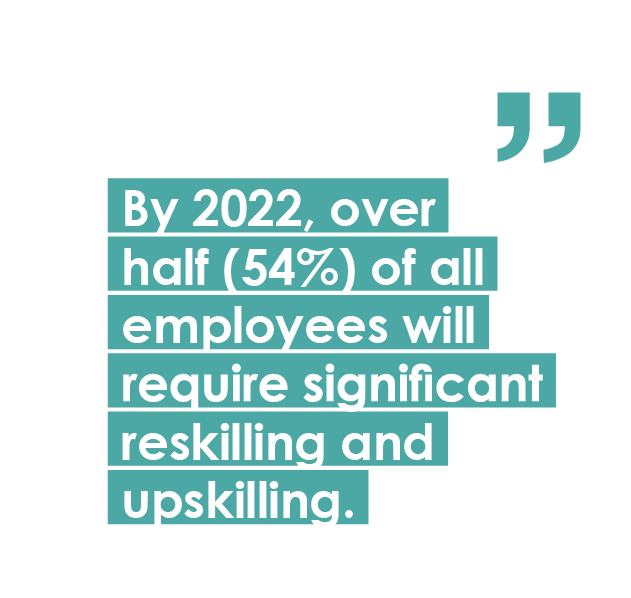At the same time, companies are scaling their upskilling so their human workforce can perform new and complementary roles to those done by machines. The skills revolution is in full flow, and employers need a new talent strategy to help their people augment robots rather than be replaced by them. These are the key findings of the ManpowerGroup Outlook Employer Survey, covering 19 thousand employers in 44 countries.
Upskilling is on the up: companies are becoming builders of talent
With talent shortages at a 12-year high and new skills appearing as quickly as old ones disappear, more companies are planning to build talent than ever before, and this is projected to increase in 2020. Companies are realizing they can no longer expect to find just-in-time talent, on tap. Eighty-four percent of organizations expect to be upskilling their workforce by 2020.
Demand for digital skills growing: out with the old, in with the new
Automation is changing the skills companies need from workers, yet the speed with which this is happening across functions within organizations varies. Demand for IT skills is growing significantly and with speed: 16% of companies expect to increase headcount in IT. The opposite expectation was reported by five times less companies. Meanwhile, the availability of tech talent is increasingly scarce, and the education and experience employers require versus what exists is presenting a mismatch.
Human skills trending: hard to find, even harder to teach
Demand for tech and digital skills is growing across all functions yet employers place increasing value on human skills as automation scales and machines prove better at routine tasks. While 38% of organizations say it is difficult to train in-demand technical skills, 43% said it is even harder to teach the soft skills they need such as analytical thinking and communication. Candidates who can demonstrate higher cognitive skills, creativity and the ability to process complex information, together with adaptability and likeability, can expect greater success throughout their careers. By 2030, demand for human skills – social and emotional soft skills – is expected to grow across all industries by 26% in the U.S. and by 22% in Europe.
 Talent strategies for the skills revolution: build, buy, borrow, bridge
Talent strategies for the skills revolution: build, buy, borrow, bridge
Talent shortages are at a 12-year high and new skills are appearing as quickly as old ones disappear. Almost all (94%) employers are pursuing one or more talent strategies to secure the skills they need and companies with a plan are more confident of expanding their headcount than those that are hesitating.
All roads lead to learning
By 2022, over half (54%) of all employees will require significant reskilling and upskilling. Of these, about 35% are expected to require training of up to six months, 9% will take six to 12 months to reskill and 10% will require additional skills training of more than a year.
To really compete in the skills revolution, companies need to promote a culture of learning, provide career guidance and offer short, focused upskilling opportunities. People need to know how to prepare for high growth roles of the future and feel that their employer supports their learning. The return on investment for upskilling is clear: in North America the cost of turnover and replacement can exceed 30% of wages, while the cost of training remains less than 10% of wages. Besides providing internal inperson and online training, companies are tapping external resources to do this: 39% are partnering with outside organizations such as schools, colleges and industry bodies to build communities of talent.
People perform at their best when their role is the right fit for their natural capabilities and their strengths are understood. Assessment is the most valuable way of understanding human potential and matching people to the right role.
7 ways to ensure humans can befriend machines:
1. Leadership matters
Executives need to be the igniters of change, innovation and culture to ensure their companies become learning organizations in an era of rapidly changing skills.
2. Women are a part of the solution
Women comprise 50% of the workforce and in 2017 became more educated than men. Creating a culture where women can thrive is more critical than ever. And importantly, what works for women works for others too.
3. Understand what your workforce wants
By 2025 Millennials and GenZ will make up more than two-thirds of the global workforce. Companies must respond by incorporating NextGen work models including contract, part-time, and temporary work to attract and retain the best skills - because 87% of workers want that.
4. Know the capabilities of your people
Organizations need to use assessment, clean data and predictive performance to deploy talent in the most effective way.
5. Tailor training
Companies must replace sheep-dip approaches to training with focused strategies and guidance to develop critical, in-demand skills for their workforce.
6. Bet on soft skills
Organizations should fine-tune talent strategies to account for the fact that human skills are harder to develop than technical skills.
7. Enable humans to augment technology
Companies must continuously upskill their workers and create talent. They must assess and reevaluate the skills they need to ensure human talent complements automation.
The full version of the ManpowerGroup Outlook Employer Survey can be found at:
https://manpowergroup.com/workforce-insights/world-of-work/skills-revolution-series



Follow us